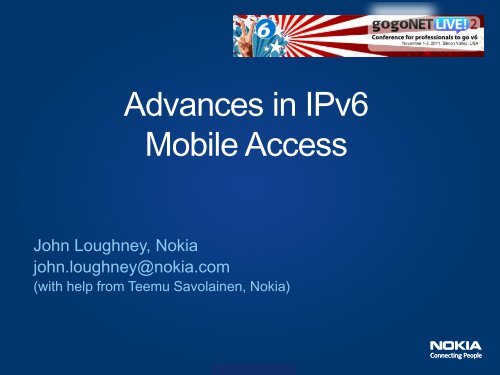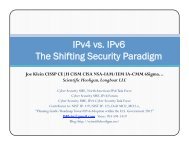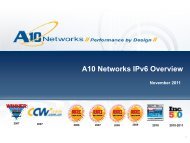Advances in IPv6 Mobile Access - gogoNET LIVE!
Advances in IPv6 Mobile Access - gogoNET LIVE!
Advances in IPv6 Mobile Access - gogoNET LIVE!
You also want an ePaper? Increase the reach of your titles
YUMPU automatically turns print PDFs into web optimized ePapers that Google loves.
Company Confidential<strong>Advances</strong> <strong>in</strong> <strong>IPv6</strong><strong>Mobile</strong> <strong>Access</strong>John Loughney, Nokiajohn.loughney@nokia.com(with help from Teemu Savola<strong>in</strong>en, Nokia)
Company ConfidentialOverviewMotivations for <strong>IPv6</strong> <strong>in</strong> mobile networksMa<strong>in</strong> <strong>IPv6</strong> Deployment options <strong>in</strong> mobile networksHandset support for <strong>IPv6</strong>Network support for <strong>IPv6</strong>Key challengesPractical advice
Company ConfidentialMotivations• 5.3 billion mobile subscribers, ITU-T figures for 2010.• Large percentage are IP capable−Trend toward Always-On applications (details next slide)• LTE is happen<strong>in</strong>g now, will be soon do<strong>in</strong>g voice over IP only.• Operators run both a circuit switched and IP networks,caus<strong>in</strong>g higher CAPEX and OPEX.• In the future, services will migrate to IP.• Carrier grade NATs are a misnomer.• So the choice is between−IPv4 with NAT frequent keep-alives & additional <strong>in</strong>vestments−<strong>IPv6</strong> and long lived connections
Company ConfidentialNATs with keep alive messages• IPv4 <strong>Mobile</strong> Devices are usually beh<strong>in</strong>d IPv4 NATs−Always on application are becom<strong>in</strong>g more prevalent−Applications that want to be reachable need to sendperiodic keep-alives to keep NAT state active− Current NATs require keep-alives from 40 seconds to 5 m<strong>in</strong>utes− Need to implement for m<strong>in</strong>imum (~30 seconds)• Send<strong>in</strong>g of NAT periodic keep-alive messages decreases mobiledevice standby time by several days• Not a problem for devices with power cords, but for mobile devices itis a big problemClient, PrivateIPv4 address 1There should be NONATs between theterm<strong>in</strong>al and theserver!Client, PrivateIPv4 address 2 UDP port = 6538The UDP <strong>in</strong>activity timer <strong>in</strong> NATs causes thepublic UDP port 6538 to be assigned to adifferent mobile, if the mobile does not send anydata with<strong>in</strong> a certa<strong>in</strong> amount of time, about every40 seconds …Server, Public IPv4 address 3
Company Confidential<strong>IPv6</strong> Trial Checklist• <strong>IPv6</strong> enabled routers and switches• <strong>IPv6</strong> transit provider and peer<strong>in</strong>g• <strong>IPv6</strong> enabled hosts• <strong>IPv6</strong> enabled apps• Address plann<strong>in</strong>g, address config, DNS• Transition mechanism(s) selection• Fallback plann<strong>in</strong>g• Middlebox support (firewalls, proxies, etc.)5 © Nokia 2011 Filename.pptx v. 0.1 YYYY-MM-DD Author Document ID [Edit via Insert > Header & Footer]
Deployment approachesDual-stack approach is the mostcustomer-friendly solution fortransition<strong>in</strong>g to <strong>IPv6</strong>Dual-stack is also the standardapproach (3GPP) and appears to bethe most favored approach<strong>IPv6</strong>-only transition solution based onprotocol translation can cause servicediscont<strong>in</strong>uity, and is only an option forspecific cases due to discrete reasons6Company Confidential
Details of dual-stack3GPP release-8 <strong>in</strong>troduced a new bearertype: IPv4v6IPv4 and <strong>IPv6</strong> bearers can be used <strong>in</strong>parallel when IPv4v6 is not supported(s<strong>in</strong>ce 3GPP release-99)Various fallback scenarios are <strong>in</strong>volvedthat are not present with IPv4-onlydevices, e.g. IPv4v6 -> IPv4 & <strong>IPv6</strong>7References: 3GPP release-8 23.060, 23.401draft-ietf-v6ops-3gpp-epsCompany Confidential
Details of <strong>IPv6</strong>-onlyEveryth<strong>in</strong>g, <strong>in</strong>clud<strong>in</strong>g applications, MUST BE<strong>IPv6</strong> enabled – otherwise solutions such asNAT46 on a host (aka BIH) may be needed<strong>IPv6</strong> is not always available: no supporton visited network, blocked on purposedue lack of roam<strong>in</strong>g agreements..Fallback support to IPv4-only mode ismandatoryThis is pretty much the end-scenarioworld is transition<strong>in</strong>g towards8Company Confidential
Company Confidential<strong>IPv6</strong> impacts at all levelsServices & ContentApplicationsGoogle, YouTube, Akamai, Facebook, B<strong>in</strong>g, ...Browsers, E-mail, IM, VoIP, Games, Utilities,Middleware entities like HTTP, ...API Qt, Java, Posix, Symbian & other OS APIs, ...TCP/IP StackModemSymbian, iOS, Android, W<strong>in</strong>dows Phone,various flavors of L<strong>in</strong>ux, Series 40, RIM,Renesas, Qualcomm, ST-E, GCT, Broadcom,Icera (Nvidia), Marvell, Inf<strong>in</strong>eon, MediaTek, ...
<strong>IPv6</strong> on handsets<strong>IPv6</strong> support requiredat different levels<strong>IPv6</strong> support on the applications<strong>IPv6</strong> support on APIs<strong>IPv6</strong> support on the connection manager<strong>IPv6</strong> support on the TCP/IP stack<strong>IPv6</strong> support on the modem10Company Confidential
Status of term<strong>in</strong>als<strong>IPv6</strong> support requiredby the bus<strong>in</strong>ess<strong>IPv6</strong> support on the applications<strong>IPv6</strong> support on APIs<strong>IPv6</strong> support on the connection manager<strong>IPv6</strong> support on the TCP/IP stack<strong>IPv6</strong> support on the modem11Company Confidential
Company ConfidentialPhone support for <strong>IPv6</strong>LG VL600CDMA/LTEdongleAndroidMotorola DroidBionic handset forVerizonReportedly has have<strong>IPv6</strong> for cellular.Samsung Nexus SHas <strong>IPv6</strong> for WLANonly.iPhone 4S<strong>IPv6</strong> for WLANonlyW<strong>in</strong>dows Phone 7MangoIPv4 only as no <strong>IPv6</strong>yet on WP OS;com<strong>in</strong>g <strong>in</strong> ApolloSymbianHas supported <strong>IPv6</strong>s<strong>in</strong>ce 2004, and used<strong>in</strong> trials. Apps canuse IPv4 or <strong>IPv6</strong>cellular access butnot bothsimultaneously. Thisworks normally whenus<strong>in</strong>g WiFi access.Nokia N9<strong>IPv6</strong> add-onenables dualstack<strong>in</strong> 3G andWiFi accesses.Nokia 21M-022G/3G /3.5G USBdongleSupports <strong>IPv6</strong> andIPv4v6 PDP types
Company ConfidentialHigh level cellular requirements• Dual-stack with s<strong>in</strong>gle PDP (<strong>IPv6</strong>v4) is the most common solution• Some network operators are consider<strong>in</strong>g dual-stack with parallel PDPs(<strong>IPv6</strong> & IPv4).− It is required for a 3GPP fallback scenario.• <strong>IPv6</strong>-only solution is also required by a few• Other solutions are also queried and <strong>in</strong>vestigated, but not required yet− PNAT, DS-Lite, DSMIP6, A+P & DS-Lite, 6rd.• Configurability to s<strong>in</strong>gle PDP (IPv4v6), parallel PDPs (<strong>IPv6</strong> & IPv4), or only<strong>IPv6</strong>− OMA DM (operator configuration) for APN sett<strong>in</strong>g• Gradual fallback <strong>in</strong> roam<strong>in</strong>g and error cases for improved user experience− IPv4v6 ► IPv4 & <strong>IPv6</strong> ► IPv4 or <strong>IPv6</strong>− <strong>IPv6</strong> ► IPv4
<strong>IPv6</strong> status on mobile networks• Closed <strong>IPv6</strong> trials at least s<strong>in</strong>ce 2003• First commercial <strong>IPv6</strong> deployments at 2010− While many operators are conduct<strong>in</strong>g <strong>in</strong>ternal (lab) trials• Public trials and some commercial deployments occurr<strong>in</strong>gdur<strong>in</strong>g 2011− Even more operators are trial<strong>in</strong>g− Number of cellular <strong>IPv6</strong> capable devices also <strong>in</strong>creas<strong>in</strong>g• And th<strong>in</strong>gs are gett<strong>in</strong>g even better for 2012 !• But there are some gotchas14Company Confidential
Company ConfidentialGotchas15
Company ConfidentialDNS server address discovery• This has been a difficult topic <strong>in</strong> IETF...• 3GPP cellular access1. MUST take the address from PDP activation2. Stateless DHCPv6 can be optionally supported3. RA based approach can be supported but as not <strong>in</strong>cluded <strong>in</strong>3GPP specs, it is not someth<strong>in</strong>g that can be depended upon.• WiFi access1. Stateless DHCPv6 is currently most widely available2. RA based solution will probably be <strong>in</strong>creas<strong>in</strong>gly available asstandard RFC6106 exists (and e.g. RADVD supports thishence L<strong>in</strong>ux based routers can easily have this)• In the dual-stack case, it is just f<strong>in</strong>e to talk to the DNS serverover IPv4, but <strong>IPv6</strong> should be preferred (as general pr<strong>in</strong>ciple)
Company ConfidentialDNS query send<strong>in</strong>g procedures• Four possibilities for query<strong>in</strong>g IPv4 and <strong>IPv6</strong> addresses:1) AAAA and A sequentially (Android, Maemo, Ubuntu)2) A and AAAA sequentially (W<strong>in</strong>dows 7, Symbian)3) AAAA and A parallel4) A and AAAA parallel (iOS, OS/X)• Use of 3 or 4 avoids extra RTT <strong>in</strong> dual-stack networks• The approach of send<strong>in</strong>g A first is due to some legacy DNSservers screw<strong>in</strong>g up if they get AAAA followed by A.. So A firstmay be slightly safer.• Important to prefer <strong>IPv6</strong> when both can be used
Company Confidential”Happy Eyeballs”Endpo<strong>in</strong>ts issue DNS queries for AAAA and A resourcerecords and then attempts connections to <strong>IPv6</strong> andIPv4 addresses sequentially. If the <strong>IPv6</strong> path is broken(or slow), it can take a long time before it falls back toIPv4 result<strong>in</strong>g <strong>in</strong> delays from 20 seconds to severalm<strong>in</strong>utes if the <strong>IPv6</strong> path is broken.Apps can improve the user experience by moreaggressively mak<strong>in</strong>g connections on <strong>IPv6</strong> and IPv4by us<strong>in</strong>g a variety of algorithms.In this approach, the application makes itsconnection attempts more aggressively over both<strong>IPv6</strong> and IPv4. Initially, the connection attempts aremade <strong>in</strong> order to provide a fast user experienceDNShostDual-StackWLANFWDual-StackInternetWWW1)<strong>IPv6</strong>Silent drop2)<strong>IPv6</strong>ICMPv6 no route3)<strong>IPv6</strong>ICMPv6 address unreachable
<strong>IPv6</strong> changes tether<strong>in</strong>g significantlyTraditional dial-up style IPv4tether<strong>in</strong>g uses dedicated PDPcontext for the dial-upTraditional dial-up is possiblealso with <strong>IPv6</strong>IPv4 tether<strong>in</strong>g solutions, often useNAT and DHCP to allow shar<strong>in</strong>g ofthe same mobile connection with<strong>in</strong>ternal applications<strong>IPv6</strong> does not use NATt<strong>in</strong>g, but <strong>in</strong>stead NeighborDiscovery Proxy ”bridg<strong>in</strong>g function” that does not requireexplicit network support, or explicit and more properDHCPv6 Prefix Delegation as is def<strong>in</strong>ed <strong>in</strong> 3GPPRelease-1019Company Confidential
Bridg<strong>in</strong>g and DHCPv6 illustrated”Bridg<strong>in</strong>g” with Neighbor DiscoveryProxy – no explicit network support isrequired!PDN GWDHCPv6 Prefix Delegation – support<strong>in</strong>cluded <strong>in</strong> 3GPP s<strong>in</strong>ce Release-10PDN GW &DHCPv6 serverPDP2001:0db8:0:1::/64PDP2001:0db8:0:1::/64f(”proxy”)Sameprefix onboth l<strong>in</strong>ksf(”router”)Handset(possibly with DHCPv6 server)Delegated e.g. 2001:0db8::/562001:0db8:0:1::/642001:0db8:0:81::/642001:0db8:0:C1::/64WLANWLANf(”router”)WLAN20Company Confidential
Illustration of basic WiFioffload<strong>in</strong>g technologiesunder studyInternetWiFi accessCellular operator’sservicesRout<strong>in</strong>grule DBRules via DHCPv6CellularaccessProvision<strong>in</strong>g rules with OMA-DMDHCPv6server21RFC4191draft-ietf-mif-dhcpv6-route-optiondraft-ietf-mif-dns-server-selectiondraft-korhonen-mif-ra-offload3GPP 24.312 ANDSFRules via <strong>IPv6</strong> Router AdvertisementsCompany Confidential<strong>Access</strong> NetworkDiscovery and SelectionFunction(ANDSF) PDN GW
<strong>IPv6</strong> standards are readyKey specifications and standards are complete andmatured for product creation and deploymentAdditional features and improvements areactively researched, developed, and standardized. Nokiaparticipates, for example, to: <strong>IPv6</strong> protocol ma<strong>in</strong>tenance,Multi-Interface improvements, IP mobility solutions,protocol translation topics, and Happy Eyeballs22Company Confidential
Company ConfidentialRecommendations• Networks are gett<strong>in</strong>g deployed – use them• Get a handset that supports <strong>IPv6</strong> on both cellular and wifi• Make sure you have apps that can speak both IPv4 and <strong>IPv6</strong>−Don’t make address assumptions−Address assignments are handled differently depend<strong>in</strong>g what<strong>in</strong>terface is used• Make sure your apps implement a ‘happy eyeballs’ algorithm









